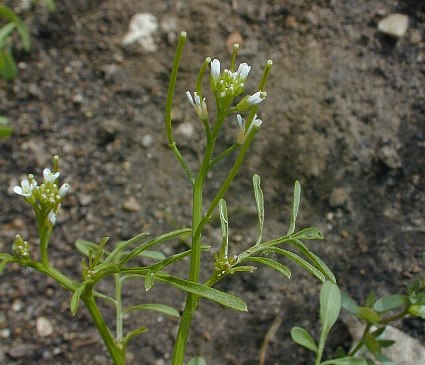Annuals; (slender); glabrous or sparsely to densely pubescent throughout. Rhizomes absent. Stems (simple or few to several from base), erect, (somewhat flexuous), often branched distally, (0.5-)1-3(-4) dm. Basal leaves (often withered by anthesis), usually not rosulate, pinnately (5 or) 7-13(-17)-foliolate, (2-)4-10 cm, leaflets sessile or petiolulate; petiole 0.5-2.5(-4.5) cm; lateral leaflets similar to terminal, sometimes smaller; terminal leaflet (sessile or petiolule to 0.5 cm), blade linear to oblong, oblanceolate to obovate, or suborbicular, (0.1-)0.3-1 cm × 1-7 mm, base cuneate, margins entire or 3(-5)-toothed or -lobed. Cauline leaves 5-10(-14), (5-)9-15(-17)-foliolate, petiolate, leaflets sessile; petiole 0.3-1 cm, base not auriculate; lateral leaflets similar to terminal, sometimes smaller; terminal leaflet blade filiform, linear, or narrowly oblong, 0.3-1(-1.6) cm × 0.3-3 mm, margins usually entire, rarely 1-3-toothed. Racemes ebracteate. Fruiting pedicels divaricate or ascending, 4-10 mm. Flowers: sepals oblong, 1-1.5(-2) × 0.3-0.5 mm, lateral pair not saccate basally, (margins membranous); petals white, oblanceolate, (1.5-)1.8-2.5(-3) × 0.4-0.8(-1) mm; filaments 1.4-2.5 mm; anthers ovate, 0.2-0.4 mm. Fruits linear, (torulose), (0.5-)1-2(-2.5) cm × 0.6-0.9 mm; ovules 20-50 per ovary; style 0.3-0.7(-1) mm. Seeds pale brown, oblong-ovoid, 0.6-0.9 × 0.4-0.6 mm, (narrowly margined or not). 2n = 16.
Flowering Mar-Jun. Roadsides, stream banks, rocky crests and outcrops, crevices of granitic bedrock, dry woods, glades, fallow fields, disturbed ground, limestone barrens, marsh and swamp margins, floodplains, waste ground, slopes, ledges, cliffs, meadows; 0-1500 m; Alta., B.C., Man., N.B., Nfld. and Labr. (Nfld.), N.W.T., Ont., Que., Sask.; Ala., Ark., Conn., Del., D.C., Fla., Ga., Idaho, Ill., Ind., Iowa, Kans., Ky., La., Maine, Md., Mass., Mich., Minn., Mo., N.H., N.J., N.Y., N.C., Ohio, Okla., Oreg., Pa., R.I., S.C., Tenn., Tex., Vt., Va., W.Va., Wis.; Eurasia.
Within Cardamine parviflora, in the broad sense, two species or varieties have been recognized: the Eurasian C. parviflora (or C. parviflora var. parviflora) versus the North American C. arenicola (or C. parviflora var. arenicola). Nuclear DNA data suggested a sister relationship of the North American and Eurasian entities, while cpDNA data showed them intermingled (J. Lihová et al. 2006). There are no apparent morphological differences between these entities, although detailed morphological studies are still lacking. We currently prefer to treat them as a single taxon.
Annual or biennial herb 10 - 30 cm tall
Stem: upright to spreading, mostly unbranched.
Flowers: in a loose, branched cluster, stalked, white, 1 - 4 mm long. Sepals four, green. Petals four, longer than sepals. Stamens six.
Fruit: a narrow pod, upright on an ascending stalk, 2 - 3 cm long.
Basal leaves: few or none at flowering, pinnately divided, stalked. Terminal leaflet oblong to broadly triangular.
Stem leaves: four to ten or more, alternate, pinnately divided into long, thin, similar leaflets (three to six pairs), stalked, mainly 2 - 4 cm long. Terminal leaflet 1 - 3 mm wide, linear to triangular-oblong, sometimes toothed. Lateral leaflets not much smaller (1 - 3 mm wide), linear to linear- spatula-shaped or narrowly oblong.
Similar species: The similar Cardamine pensylvanica is larger and grows in wet habitats. Also, its terminal leaflet is broader than the lateral leaflets, and the leaflet bases extend down along the leaf axis. The stem leaves of C. hirsuta differ by having a marginal fringe of hairs at the base of their leafstalks.
Flowering: mid-April to early July
Habitat and ecology: A plant typically found in the dry soil of lawns, fields, and open woods; in both shade and sunlight. In the Chicago Region, it has been found growing in ditches, fallow fields (often cornfields), and poorly drained old fields. In a dolomite prairie they were seen occupying the areas containing bare soil and exposed rock.
Occurence in the Chicago region: native
Etymology: Cardamine comes from the Greek word kardamon, which refers to plants in the cress family. Parviflora is Latin for "small flower."
Author: The Morton Arboretum
This species is probably found in all parts of the state except in the rich, neutral soil of the central part. It is rare to infrequent and is usually found in dry soil in bare spots in woodland under black and white oak or in a habitat simulating this one. On these bare spots the plants may be only 2-3 inches high but on or near the border where the leaf mold and vegetation about such places begin the largest plants will be found. The plant is so delicate that it can not push its way through leaf mold or compete with much vegetation. There are, however, plants that must belong to this species that are found in moist, clay soil in fallow fields where they are usually associated with Agrostis hyemalis, Cardamine pennsylvanica, Hordeum pusillum, and Arabis virginica. I am of the opinion that both habitats have slightly acid soil.
Annual or biennial with glabrous, mostly solitary stems 1-3 dm; terminal lfl of basal lvs oblong to broadly cuneate-obovate; cauline lvs commonly 2-4 cm, with 3-6 pairs of segments, the terminal segment linear to cuneate-oblong, entire or toothed, the lateral not much smaller, linear to linear-spatulate or narrowly oblong, usually 1-3 mm wide and entire, not decurrent; fls and fr much like no. 13 [Cardamine pensylvanica Muhl.], but the stylar beak not over 1 mm; 2n=16. Usually in dry soil; Que. and Nf. to Minn., s. to Ga. and Ark.; also in the Old World. The Amer. pls are var. arenicola (Britton) O. E. Schulz.
Gleason, Henry A. & Cronquist, Arthur J. 1991. Manual of vascular plants of northeastern United States and adjacent Canada. lxxv + 910 pp.
©The New York Botanical Garden. All rights reserved. Used by permission.





